
magazine DIXIE STATE UNIVERSITY MAGAZINE | SPRING 2017 Finding Strength at Dixie pg. 12 Honoring Coach Allred pg. 24 Our Fading Stars pg. 26 Inventor & DSU Mentor Wayne Provost
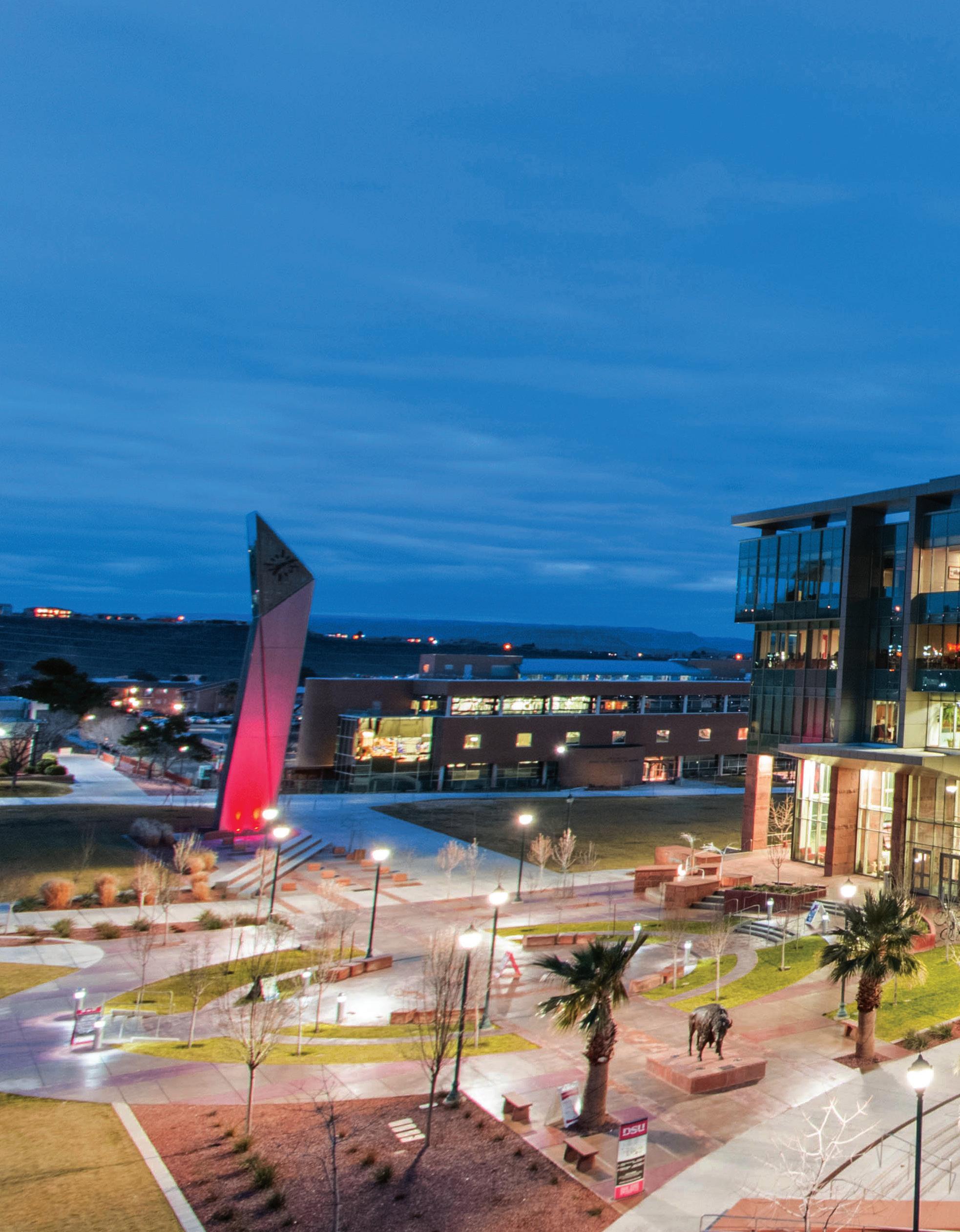
 Inside Cover Photo: Bryce Parker
Inside Cover Photo: Bryce Parker
Editor-in-Chief
Joel Griffin
Art Director
Scott Garrett, ’15
Illustration & Design
Scott Garrett, ’15
Kimberly Sanna
Josh Bodell
Teslim Dawodu
Colton Campbell
Valerie De La O
Photography
Scott Garrett, ’15
Bryce Parker
Caitlyn Cody
Alex Chamberlain
Gymshark
Writers
Joel Griffin
Jyl Hall
Steve Johnson
Chet Norman, ’15
Ashley Imlay
Austin Osborne
Jordon Sharp
Copy Editors
Joel Griffin
Jyl Hall
Steve Johnson
Jordon Sharp
Deborah Millet
Austin Osborne
Bailee Christiansen
Lindsay Olson
Feedback griffin@dixie.edu
435-879-4412
To Update Contact Information alumni.dixie.edu/update-your-records
Inventor Wayne Provost helps DSU students develop their bright ideas as part of the newly proposed Technology, Innovation, and Entrepreneurship Center.

DSU magazine - Spring 2017 Issue
DSU in the News active learning. active life. Focal Point 4 4 7 26 ON THE COVER Inspiring Brilliance
DEPARTMENTS Letter from President Williams
18
Cover Photo: Scott Garrett, ’15
Dixie alumni Markay Johnson, Anthony McMullin, and Kasi Miller give updates on the pursuit of their dream careers.
Fitness icon, Internet sensation, and former Dixie athlete Steve Cook overcame life struggles to make it big as a bodybuilder.
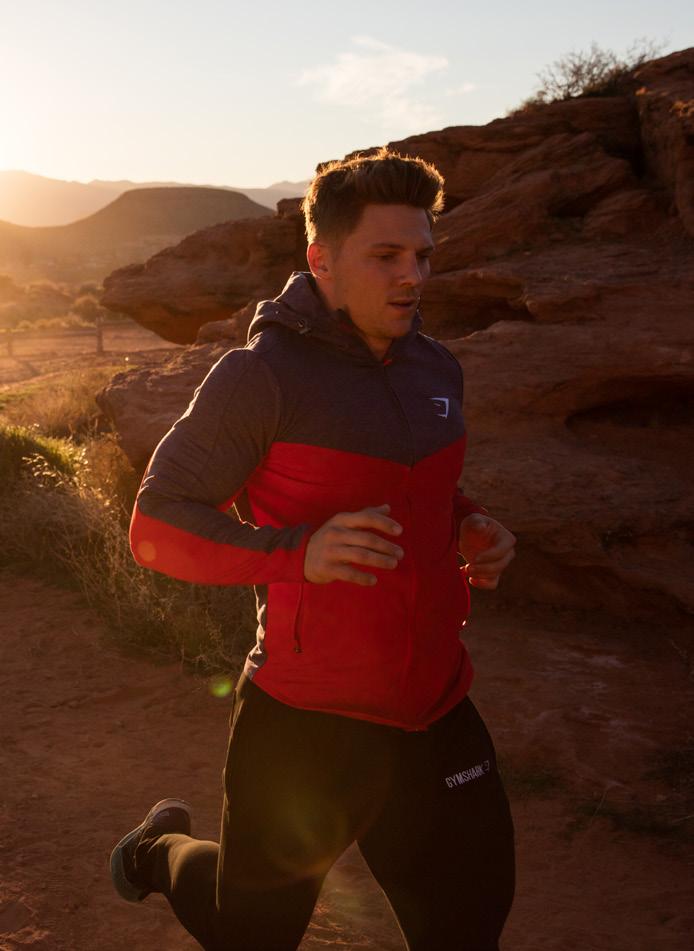
The City of St. George and DSU are working hand in hand to place bison statues, painted by local artists, around town.

Honoring Coach Doug Allred
Former Dixie basketball players visit campus to honor Coach Doug Allred.
Remembering Sark Arslanian
DSU honors the legacy of Dixie College Coach and Hall of Famer Sark Arslanian.
Hall of Fame
Dixie State welcomes five new inductees into its Athletic Hall of Fame.


3 #ActiveLearningActiveLife • www.dixie.edu • 8 12 16 24 32 34 FEATURES Hot on the Trail Finding Strength at Dixie Trailblazer Art in the City
TABLE OF CONTENTS 12 16 24 26
Trailblazer Nation
What an amazing year we have had at Dixie State University! I am beyond proud of the accomplishments our institution and its students, alumni, faculty, and staff have achieved throughout this recordbreaking year.
Dixie State kicked off the 2016-17 academic year with the largest percentage increase in full-time equivalent students out of any other institution in the Utah System of Higher Education. In that vein, we also welcomed our largest ever freshman class to campus this fall. I am excited to see all that these students will accomplish in the next four years.
To meet the needs of our growing student population, we are expanding our academic offerings. We are poised to add a record seven new majors throughout 2017. This will bring our total up to 37 distinct majors, an incredible feat considering that Dixie offered only five baccalaureate majors in 2005. These new degree programs represent so much more than Dixie’s growth; they denote opportunities for our students to study a variety of fields right here in beautiful St. George. This year, we plan to add the following degrees:
• Bachelor of Science in Bioinformatics
• Bachelor of Arts and Bachelor of Science in Applied Sociology
• Bachelor of Science in Information Systems & Data Analytics
• Bachelor of Fine Art in Studio Art
• Traditional Bachelor of Science in Nursing
• Bachelor of Science in Recreation & Sport Management
• Bachelor of Science in Population Health with emphases in Healthcare Administration, Public Health, and Health Sciences
We are also working on adding minors in Accounting, Photography, and Graphic Design and certificates in Entrepreneurship, Social Media, Strategic Communication, and Multimedia Journalism. Additionally, the University is adding a Media Studies degree and an Applied Leadership emphasis within Communication Studies.
The State Board of Regents and Northwest Commission on Colleges and Universities must approve all programs before they can be offered, and we anticipate that the above programs will be official by the end of this August.
It is an exciting time to be a Trailblazer, and I look forward to continuing to work together to make Dixie State University the best it can be for our students and community.
DSU in the news
Dixie State Reports Largest Enrollment Increase Percentage in Utah
After final enrollment numbers were turned in this fall, the Utah System of Higher Education reported that Dixie State saw the largest percentage increase in students from 2015 to 2016 out of all Utah’s public colleges and universities.

DSU’s number of full-time equivalent students grew by 7.38 percent since last fall. Dixie leads in percentage increase in total headcount for the state as well, reporting a 5.76 percent increase over last year with 8,993 students. DSU officials also report a 22.91 percent increase in new DSU students at 2,688, including a 27.41 percent increase in freshman at 2,166 — Dixie’s largest ever freshman class.
Additionally, Dixie has made strides in increasing the number of enrolled minority students to 1,855, which is an increase of 16.01 percent over last year, and also reports a 14.12 percent increase in non-resident students.
DSU administration attributes the spike in enrollment to the University’s unified effort in accomplishing the goals laid out in its five-year strategic plan, Dixie 2020: Status to Stature.
“We have a comprehensive plan we’re implementing, and it has been a University-wide focus to be able to provide quality education to a greater amount of students,” Dixie State University President Richard B. Williams said. “There is momentum at DSU, and our progress in helping students succeed and creating an inclusive environment is making Dixie a more compelling option for potential students.”
Dr. Richard B. Williams President of Dixie State University

4 • Dixie State University Magazine • Spring 2017
Dixie State Offering New Programs this Semester

Beginning this semester, Dixie State University is offering additional minors and emphases, an online Paralegal Certificate course, and other certificate programs.
The College of Humanities & Social Sciences now offers minors in American Sign Language and Humanities. Additionally, in response to local growth and increased interest in the business sector, the College of Business & Communication added minors in Economics, Management, and Marketing.
The Department of Communication has already seen an influx of students interested in media studies and consequently has added a new Digital Film degree. Dixie has also added a Strategic Communication emphasis to the Media Studies degree and an emphasis in Health Communication to the Communication Studies degree.

To offer the community even more educational opportunities, Dixie State has teamed up with the Center for Legal Studies to offer an online Paralegal Certificate course and other certificate programs. Providing students with affordable, effective, and comprehensive legal education, the Center for Legal Studies offers non-credit bearing Continuing Education certificates in Paralegal, Legal Secretary, Legal Investigation, and Alternative
DSU and Community Build Monument to Honor Veterans
To honor the service and sacrifice of DSU veterans, the University dedicated a new Veterans Memorial on the Encampment Mall this academic year during the Veterans Day program.
The memorial features a stone monument and U.S., Utah, and DSU flags. The monument also includes lighting to illuminate the flags at night.
Spearheaded by the DSU Veterans Club, the idea for the project originated when club president Anthony Cirrito could not see the flag on the north end of campus when it was flying at half-staff.
“The whole genesis of the project was geared to bringing recognition to the veterans who are on campus,” Cirrito said. “They walk among us and you wouldn’t even know they’re here. The flag is a symbol of that.”
The memorial was a community-wide project, as all of the supplies and labor for the monument’s construction were donated via student service projects, Eagle Scout projects, community members, and local businesses.
Dispute Resolution through Dixie State’s Continuing Education program. Test prep programs for the ACT, SAT, GRE, LSAT, and GMAT are also available.
All courses are online and take place over seven weeks, with the Paralegal program requiring two seven-week sessions.
“The national median earnings for paralegals is about $44,500 per year,” Vice President of Academic Affairs and Provost Michael Lacourse said. “This affordable course is a great way to prepare for a new career. Plus, because the course is fully online, it can be done in the comfort of your own home when it is convenient for you, making it very doable for even the busiest of people.”
For more information on Continuing Education courses, visit ce.dixie.edu or call 435-652-7675.
5 #ActiveLearningActiveLife • www.dixie.edu • DSU IN THE NEWS
Technology Center Receives Facelift
The Smith’s Computer Center, home to the Department of Computer & Information Technology, recently underwent an extensive renovation.
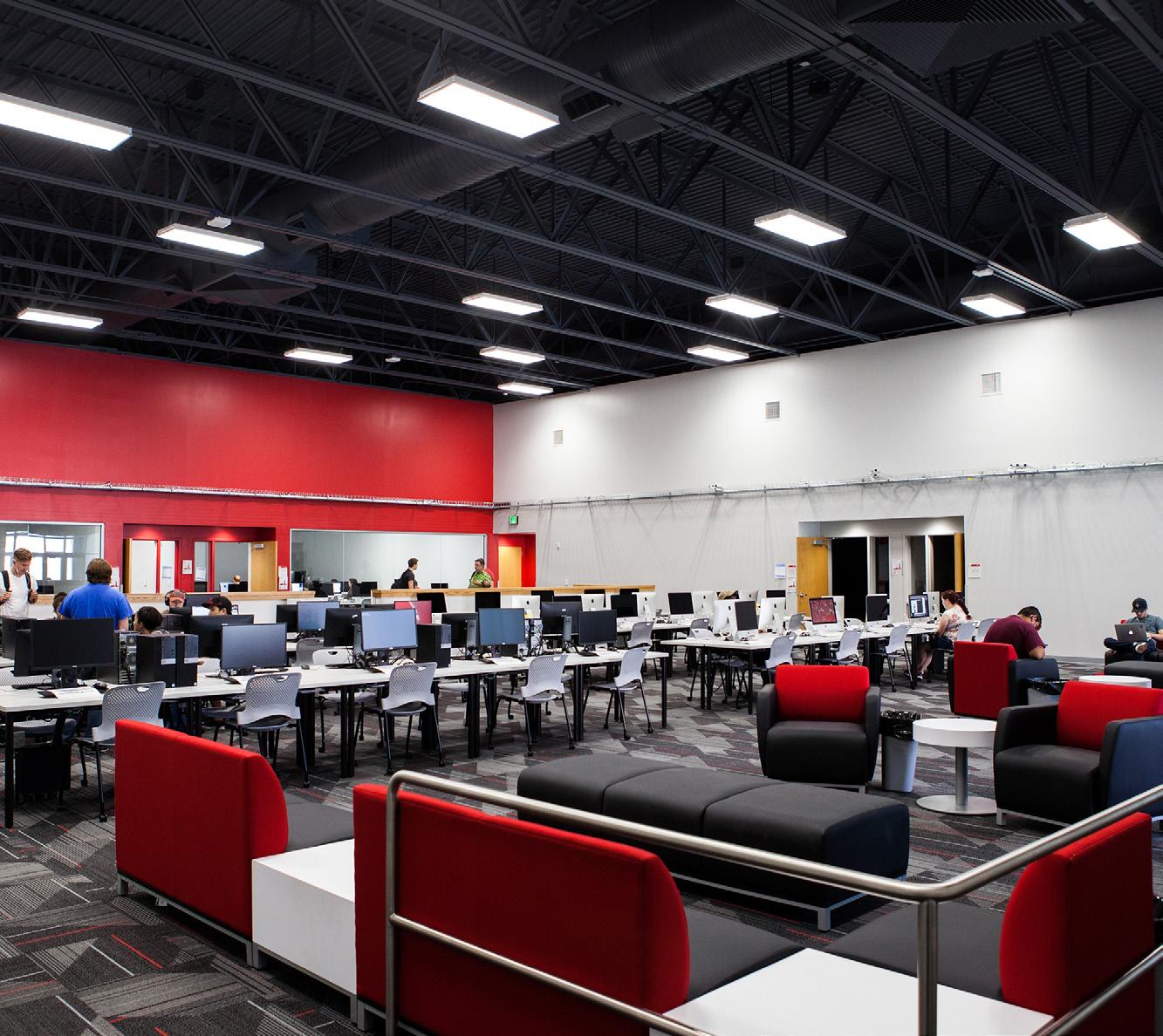
“We are excited about this new technology space designed to house our more than 425 students who are currently in the CIT and Computer Science programs as well as facilitate our community and outreach initiatives,” Eric Pedersen, dean of the College of Science & Technology, said. “We see a bright future in the growth of technology programs at Dixie State University and the Smith’s Computer Center will be a great place to learn about design, web, information technology, software development, and computer science.”
For more information about Dixie State University’s Department of Computer & Information Technology,


DSU IN
NEWS
THE
active learning. active life.
THE UNNING PROFESSOR
Ross Decker, an associate professor of mathematics, inspires students both in the classroom and on the track. Lured by the area’s gorgeous scenery and recreational opportunities, he moved to St. George from Mesa, Arizona, with his family 18 years ago. He has been teaching — and running — here ever since.

In his 32 years of teaching, Decker says the connections he has made are what he cherishes most. “I remember faces, and I love seeing former students. There are still many that I’m in contact with,” he says. “That’s the best part of the job — getting to know people. They affect me, and hopefully I have an effect on them too.”
When he’s not explaining pre-calculus and trigonometry in class, the 57-year-old professor serves as assistant coach to DSU’s cross country teams and participates regularly in the St. George Marathon, Huntsman World Senior Games, and several triathlons. He is a three-time triathlon winner and even competed in Quebec after qualifying for the Half Ironman championship. His years of racing experience have shaped him into an effective mentor to others in their running.
“Every time I run the marathon, I tell people who ask for advice: ‘Set a lot of goals, so you can at least accomplish some minor ones, and if you have a perfect day, maybe you achieve all of them,’” he says.
In terms of his own goals, this last October, Decker ran the St. George Marathon in three hours and one minute. Three hours is an important benchmark time for marathon runners and one that Decker has broken many times, but he hopes to break it once more in next year’s marathon. He also aims to compete in the Half Ironman championship again, and qualify for an Ironman championship, which accepts the top two percent of competitors in each age bracket.
In the Decker family, “running goes deep,” Decker says. Two of his sons competed on Dixie’s cross country team, one of which has since become head coach — Justin Decker. Although Decker qualifies for the Boston Marathon every year — and has run it once already — he looks forward most to returning with his sons and running it together.
“I’ve challenged them,” he says. “I’ve told them, ‘You qualify for the Boston






Marathon, I’ll pay for us to go back and do it together.’ It’s like a little carrot I dangle out there for them.”
Before then, however, Decker will reappear in a race that few, if any, have won more than he: the Great Race of D-Week. It’s a tradition that started as a bike race in the 1960s and then turned into a 10-man relay in the 1970s that added running, dirt bikes, horseback riding across Foremaster Ridge, and tubing down the Virgin River. After fading out at the end of the 80s, the Great Race was brought back years later in a modified on-campus version in 2000. Decker has run it every year since its resurrection and has taken first place eight times with a number of teammates over the years.
After taking second place to the X-Club last year, Decker is determined to win the trophy back.
“I don’t know who’ll be on the team this year,” he says, “but one thing is for sure: X-Club better watch out.”
Story by Ashley Imlay
• Design by Teslim Dawodu • Photography by Bryce Parker
HOT ON THE TRAIL
Catching up with Dixie Alumni
Markay Johnson, ’74
Markay Johnson is a builder. For him, it all began at Dixie, where he learned and perfected his passion for mathematics while preparing to become a structural engineer. Now, he builds luxurious custom homes across the country for highend clients and executives of companies like Google and Apple.
“Dixie truly prepared me to succeed in my life,” Johnson says. “My connections there have been endless. I have met people while traveling around the world who attended Dixie and we all have a warm spot in our hearts for it. I got hired into my first engineering position, out of all the other candidates, simply because I went to Dixie.”
Since the establishment of Markay Johnson Construction, he has gained more than 30 years of experience in the custom home business and has relocated back to his roots in Utah’s Dixie.

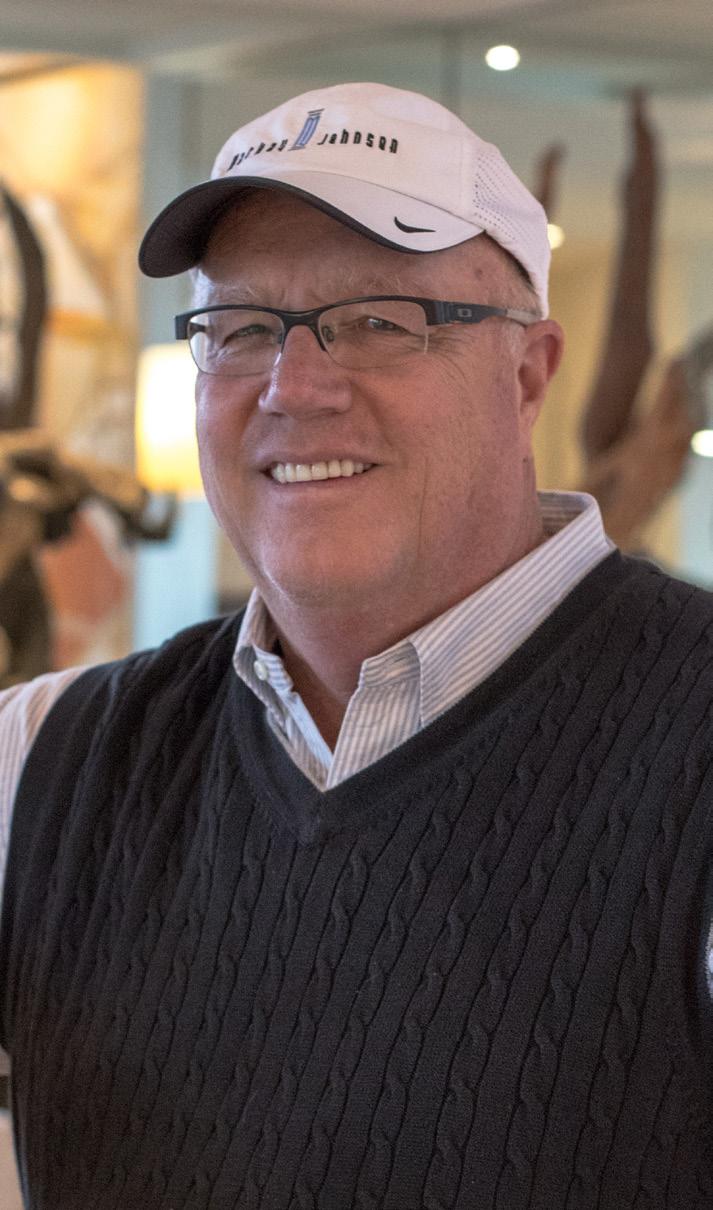
8 •
State University Magazine • Spring 2017
Dixie
Story by Chet Norman, ’15 & Austin Osborne Design by Josh Bodell
Photography by Scott Garrett, ’15
Every day of Anthony McMullin’s work presents new challenges. As the founder and managing attorney of McMullin Legal Group, PLLC, he is a strong advocate for clients who have been injured by the negligent actions of others. According to McMullin, lessons at Dixie helped him focus on his end goal of being an attorney.

“I developed the characteristics of determination and discipline while at Dixie,” McMullin says. “The hands-on approach from my professors helped me learn and think analytically. It was challenging at times, but through hard work and effort, success followed.”
McMullin belongs to a long line of Dixie graduates and determined early on that he wanted to be one as well. “The combination of education, location, and resources Dixie offers is an unmatched value when compared to other universities,” he says.
9 #IWentToDixie • www.dixie.edu •
ALUMNI SPOTLIGHT
Anthony McMullin, ’05
Kasi Miller, ’96

With designs in both residential and corporate settings, you can find her work showcased throughout the St. George Area Parade of Homes as well as in local businesses like Brick Oven, The Pizza Factory, Swig’s corporate office and Focus Eye Center.
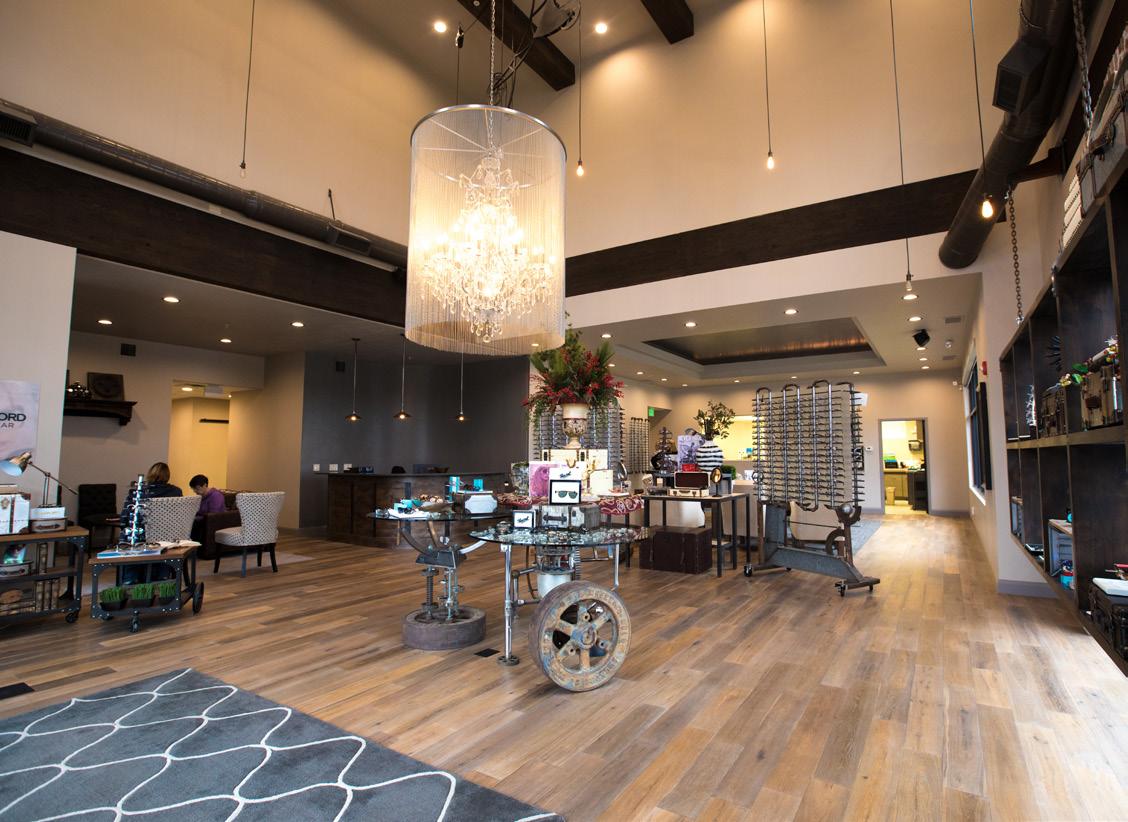
“I love what I do,” Miller says. “It gives me a creative outlet and is one of the greatest loves of my life.”
“It was so personal and such a great experience,” Miller says. “I wasn’t just a number. Being


able to go to college and be part of a community right out of the gate was a huge help to me.”
Interior design has been Kasi Miller’s dream career since her youth. Now as the owner of Kasi Miller Designs, she works hard to provide quality work she can take pride in.

Miller has lived in St. George her entire life and says her time at Dixie was a springboard for her personal and professional life.



ONLY AT THE DSU CAMPUS STORE! CAMPUSSTORE.DIXIE.EDU 435-652-7644 DSU Films’ productions are created by DSU faculty, staff, and students. Proceeds from DVD sales support the film program by providing funding for similar student film projects. ALUMNI SPOTLIGHT
NOW AVAILABLE
Kasi Miller Photo courtesy of Malea Ellett
$5 (Free w/ Dixie ID)

FINDING STRENGTH AT DIXIE
It’s hard to imagine Steve Cook, with his staggering online following, at one point living without Internet at his grandparents’ St. George home and working at a Texas Roadhouse while struggling to recover from a divorce. A simple Google search of Cook turns up YouTube videos, tweets, merchandise, and pictures attesting to his seamless success, but Cook paints a very different picture of what it was like getting there.
“You see people on a magazine and think they have it all together, but I was that broken kid,” he says. “It doesn’t matter where you are in life. At some point in time, that’s going to happen to you. Everyone has those times.”
For Cook, it started when his wife received a job offer in Idaho and the couple decided to move, one semester shy of his degree. Cook had been attending Dixie State on a football scholarship while studying biology and psychology. When he looks back on those first few years, he describes them as a period of profound growth.
“Dixie is where I feel like I grew up,” he says. “I was just a kid when I first arrived. I got married; I was on the dean’s list my first semester here, which was more effort than I had ever put into school. The biggest changes in my life happened at Dixie State.”
12 • Dixie State University Magazine • Spring 2017 STEVE COOK
Story by Ashley Imlay & Joel Griffin
Illustration & Design by Kimberly Sanna & Scott Garrett, ’15
#activelearningactivelife • www.dixie.edu • 13
The return to his home state of Idaho was not a happy one. An injury prevented him from continuing his football career and without the former accolades of his school days and no degree to fall back on, he started waiting tables in the throes of his identity crisis. To make matters worse, his wife wanted a divorce.
It was a wakeup call. He transferred his server job back to St. George, moved to his grandparents’ winter home, and enrolled in 16 credits at Dixie to finish his degree. “This time, though, it wasn’t about football or anybody else; I was doing it for me,” he says.
During this time of self-discovery, Cook found his passion for fitness. “I needed one more credit for a Pell Grant, so I took a fitness class here,” he says. “There’s more than just the physical nature of working out. It gave me an opportunity to re-center my life.” This class, he says, got him started in the fitness industry.
Muscle & Fitness Magazine announced its Male Model Search and Cook decided he would compete. “All I did was keep my head down, go to school, go to work, go to the gym,” Cook says. “I changed more, both physically and mentally, during that period than I had my whole life.”
He soon realized that if he could devote the same time and effort to a career he was passionate about, he would find success. When the day of competition arrived, Cook went up against more than 250 competitors and won — it was the event that launched his career.
Good things started to happen for Cook. He signed with bodybuilding.com and Gymshark, participated in Men’s Physique Olympia, received his International Federation of BodyBuilding & Fitness Pro Card, traveled the world for two years as a sponsored athlete for Optimum Nutrition, and built connections with people all along the way. “Every person I met, I wanted to have them remember something that we talked about,” he says. “I tried to introduce myself and figure out their story.”
His ability to create these connections, his passion for fitness, and the understanding that exercise and nutrition can better people’s lives enabled him to start building his brand. “I hustled, grew a following on social media, and started getting into the YouTube space,” he says. His online support grew steadily.

Now, Cook has well over one million Instagram followers and more than 600,000 YouTube subscribers, the majority of them college-aged males. For these young men, Cook serves as a powerful role model. “At that age, you want to be the man, but you’re usually strapped for cash, you’re finding out who you really are, and I think sometimes it’s hard for guys to talk about,” he says. “They have to be the macho guy.”
He believes that fitness provides them with a better sense of focus. “I wanted to create a community. You start off in the gym and control the fitness side of things. Take that exact model, sit down, and set a goal,” he says. “If you work and it’s important to you, you’ll get it done.”
14 • Dixie State University Magazine • Spring 2017
Cook is quick to poke fun at his online image — a myriad of fitness photos touting his shirtless physique. “I call that the applesauce,” he says. “But you also need your peas and carrots,” meaning that while necessary to maintaining his brand, the photos are only a part of what he does. “They might follow me for the applesauce, but they are loyal because of the peas and carrots. There’s got to be a good balance of both. People stick around because there’s more substance to it,” he says.

The “peas and carrots” make up much of Cook’s content. He publishes his own program on bodybuilding.com, called “Big Man on Campus,” that has a workout plan and tips and tricks for college. He also has his own website, stevecookhealth.com, through which he offers a subscription-based workout plan and his own line of apparel. The literal peas and carrots come in a cookbook he wrote, titled “Cook Effect,” which has easy and healthy recipes and is available online at cookeffect.com
Still, he hasn’t forgotten his struggle. Through his businesses and social media accounts, he uses his experiences to inspire others to live more balanced lives. “Life’s not about having a six pack,” Cook says. “You can always be better, but telling yourself, ‘I’ll be happy when’ just isn’t true; you have to be happy with who you are.”



STEVE COOK
Photography provided by Gymshark
Trailblazer ART IN THE CITY
Story by Jordon Sharp
Design by Kimberly Sanna


University towns consistently rank among the most desirable places to live in the nation, bringing with them diverse cultures, athletic and cultural offerings, economic growth and security, well-maintained facilities, beautiful surroundings, and a strong collegiate spirit that permeates the community. Now, more than ever, St. George is becoming a university town.
Dixie State University and the City of St. George have been working hand in hand to increase the benefits that a university town offers. As this collaborative effort moves forward, hand-painted Trailblazer bison statues have been popping up throughout the city as part of the Trailblazer Art in the City project.
The project was designed to promote local artists and businesses, bring students and community members together, encourage a stronger university town atmosphere, and help fund future projects like it. Businesses, organizations, groups, and individuals can sponsor Trailblazer bison statues within the city annually or purchase statues of their own. Annual Trailblazer sponsorships provide businesses and organizations with brand recognition in high-traffic areas of the city while purchased Trailblazers provide personalized art pieces and create unique photo opportunities for clients and the general public to enjoy.

16 • Dixie State University Magazine • Spring 2017
DSU plans to place 20 of these painted statues throughout the community and nine have already been sold or sponsored since the project’s recent launch. When most of the statues have been placed, brochures will be distributed throughout the city and an interactive website will be posted, providing a map for interested parties to follow. For more information on purchasing or sponsoring a Trailblazer bison statue, please contact DSU Chief Marketing & Communication Officer Jordon Sharp at jsharp@dixie.edu or at 435-879-4409.



TRAILBLAZER ART IN THE CITY
Wayne Provost lights the way for students with bright ideas
Whether you are aware of it or not, Wayne Provost has probably tinkered with something in your life. His reach is so widespread, he’s even touched your cereal box. He is, after all, the inventor of the resealable carton top. As impressive as that may be, however, Provost does not care to be remembered for it.
He invented dental fiber optics, which detect cavities in your mouth, he digitized insurance claim processing and payment, and he’s had a hand in several life-saving inventions. They include the insulin pump, portable artificial kidney, and infusion line identification lighting system, which prevents healthcare professionals from making the fatal error of switching IV lines to the wrong fluid sources. The more you learn of his innovations, the more apparent it becomes that “the cereal box guy” reputation doesn’t do him justice.

These are just a few of the hundreds of patents Provost has worked on, from the simple to the sublime, and now he is at Dixie State University, teaming up with students to patent their ideas and launch businesses.

“People always ask, ‘How many patents do you have?’” he says. “Hell, I don’t know! I’m not doing it for the numbers.”

Not only has Provost lost count of the patents he’s worked on, he doesn’t know how many times he’s retired. He’s been a dental surgeon, founded and owned

12 different companies, closed multi-million dollar deals, served as a chairman and board member of several organizations, and in his younger years, was nominated as one of the Ten Outstanding Young Americans — two years after Elvis Presley.
“I’ve been a tinkerer my whole life,” he explains, remembering pulling apart toasters at the junkyard as a kid. But it wasn’t until high school that he considered he could be smart.
“Your son is a genius,” his English teacher had said to Provost’s parents. “But it’s a shame he won’t use his brilliance for good. He’s dead set on being the class clown” — he had made good on a threat to jump out the three-story classroom window if his grade wasn’t changed from a D to a C.
Provost was shocked: “I thought I was stupid, but from then on, I thought, ‘Gee, I guess I do have some smarts.’”
Retiring as class clown, Provost went on to the University of Utah, where he became close friends with Stephen Jacobsen, a fellow tinkerer and eventual Da Vinci Award winner. Provost later partnered professionally with Jacobsen on a wide array of innovations after graduate school.
During that partnership, Provost’s 17-year-old stepson, Dusty, contracted Leukemia. Despite Provost’s work on
Story by Joel Griffin Design & Photography by Scott Garrett, ’15



several inventions to assist with his care, Dusty passed away within a year. It was a turning point.



Provost subsequently founded Teens Kicking Cancer to help financially challenged families with children in chemotherapy while also offering his innovation expertise to budding inventors.


“Before Dusty’s passing, people would call me to ask how they could get a patent, and I used to send them to my patent attorneys,” Provost recalls, “But after his death, we’d meet and I’d guide them through the process; I decided I was going to help people.”

Now, coming out of his on-again-off-again retirement, Provost has opened a new chapter by becoming director of the Innovation Guidance and Solutions program in DSU’s newly proposed Technology, Innovation, and Entrepreneurship (TIE) Center.
The TIE Center is Dixie’s new resource dedicated to supporting the progression of ideas into companies. DSU’s Innovation Plaza, formerly East Elementary, will house the center, with academic programs and a new technologyfocused secondary school in the original west wing. Makerspaces will be in the newer east wing, where students can create invention prototypes under higher ceilings in a more accommodating open floor plan.
Kyle Wells, dean of Business & Communication, notes, “Innovation Plaza is meant to be more than a place to innovate, design, and create; it will be a place to cultivate the entrepreneurial spirit. Entrepreneurial education is more than just teaching about business start-ups, it is about thinking differently. It is about recognizing systems and processes in our daily lives that can be improved. It’s designed to bring innovators into a common space that encourages serendipitous connections between like-minded thinkers.”
20• Dixie State University Magazine • Spring 2017 INVENTOR WAYNE PROVOST
St. George was recently ranked by Pew Research as having the second lowest wages in the U.S. — a problem Wells hopes the center can remedy.
“We need to attract and provide a skilled labor force for prospective employers,” Wells says. “We also need to encourage the type of innovation that builds companies requiring skilled labor.”
Last year, Provost approached Wells, President Richard B. Williams, and Eric Pedersen, dean of Science & Technology, about working with students to patent their ideas.

“I love university students,” Provost says. “I mean, there are more brains in college than anywhere, and I wanted to help kids get through the patent process and turn their ideas into viable businesses.”
It didn’t take long for students to catch wind of his arrival on campus last October. “I thought maybe if I had two patents pending in a year, that would be pretty good,” Provost says. “But within the first two weeks, I had kids beating the door down.”
To date, Provost is working with 28 students, three of which already have patents pending, along with four faculty and staff members. Provost says the numbers increase daily.
Provost notes that while students are in college for four years, many of them with good ideas have less time than that before graduating. “That’s why I’m busting my chops, because the worst thing that could happen is that a student with a brilliant idea runs out of time.”
Business administration majors Nicholas Mellow and Wyatt Anderson both have patents pending, thanks to the help of Provost, or “Doc,” as he is sometimes called.
“It’s been a real mentorship. I can meet with him, call him, talk to him; I hadn’t had that kind of relationship until I met Doc,” Mellow says. “He’s hands-on every step along the way.”
Prior to receiving help from the TIE Center, Mellow felt discouraged after his design idea had not placed in two local business competitions. Then, Provost spoke as a guest lecturer and the two began an immediate collaboration.
“I felt like I was knocking on a lot of doors and they just weren’t opening,” Mellow says. “But Doc has believed in me to the point where I feel like I can get through some of the barriers to create a real business.”
Much like Mellow, Anderson felt down when his technology idea was deemed unfeasible. Disappointed that he’d narrowly missed his opportunity, Anderson confided in an advisor who




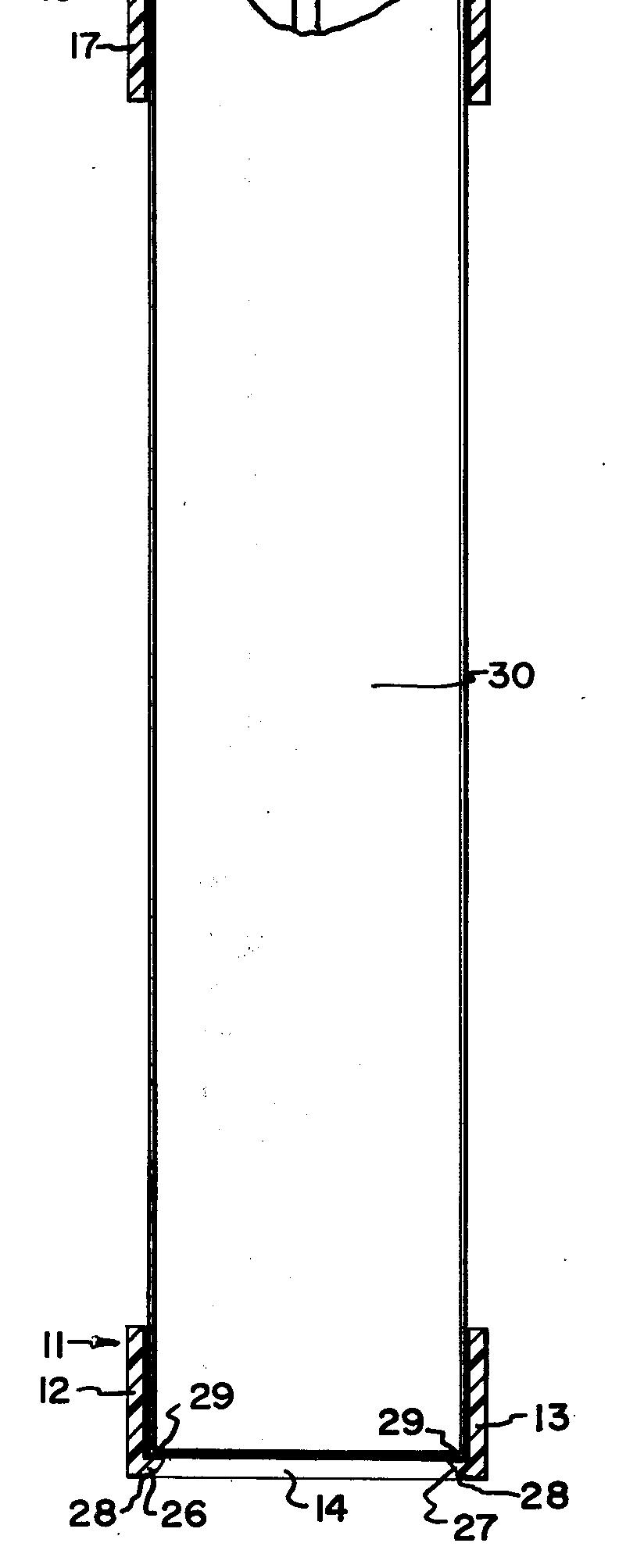
INVENTOR WAYNE PROVOST
referred him to Provost and the TIE Center.
“It’s been one of the greatest things ever,” Anderson says. “Doc says a patent is like a tree — you start out with one idea and then it branches off into others. You go so many different directions; sometimes stuff works, sometimes it doesn’t, but you just keep on going.”


While the top priority is students, the TIE Center has a broader community outreach. Airline pilot Adam Taylor first connected with the TIE Center when Provost spoke in Don Watkins entrepreneurship class, offered through DSU Community Education. Taylor thought to contact Provost about an idea he had, but only days later, Taylor was surprised when Provost called him first to propose they work together.
“He’s a passionate person who loves helping people and genuinely loves innovation — it’s in his veins,” Taylor says. “I’ve learned from this that you really have to believe that there’s something great inside of you.”
Provost says the TIE Center’s student-focused approach is a refreshing and unique change from other institutions where student involvement is often relegated to faculty assistance on patents that don’t really benefit students once they graduate.

“These kids are unbelievable,” Provost says. “This is what I live for: creating, inventing, patenting, building, and manufacturing. We’re taking a different attitude here: When you graduate from Dixie State University, you’re not looking for jobs, you’re creating them.”

22 • Dixie State University Magazine • Spring 2017
join the Dixie State Trailblazer Club to support student-athlete success on the field and in the classroom.


“Without the Trailblazer Club, I couldn’t have the astonishing experiences and resources to excel. My success wouldn’t be possible without the amazing support of Trailblazer Club members.”
Gabrielle Cabanero - Women’s Basketball
Computer & Information Technology Major
Trailblazer Club members receive:
• website and print recognition

• Coach and Athlete Meet & Greet opportunities
• Tax deduction consideration
• Athletic event tickets
• Invitations to athletic Functions
• Travel opportunities
“Although athletics are a big part of my life, it is important to also succeed off the field. Without the Trailblazer Club, I couldn’t have had the community involvement experiences I did throughout the year.”
Ryan
Rodriguez
- Baseball
Business Administration Major Visit dixiestateathletics.com and click on the giving tab or call 435-879-4295 for more information . .
- NOLAN
HONORING COACH DOUG ALLRED
On February 10, former teammates and friends reunited on the Dixie State campus to honor their beloved basketball coach, Doug Allred.

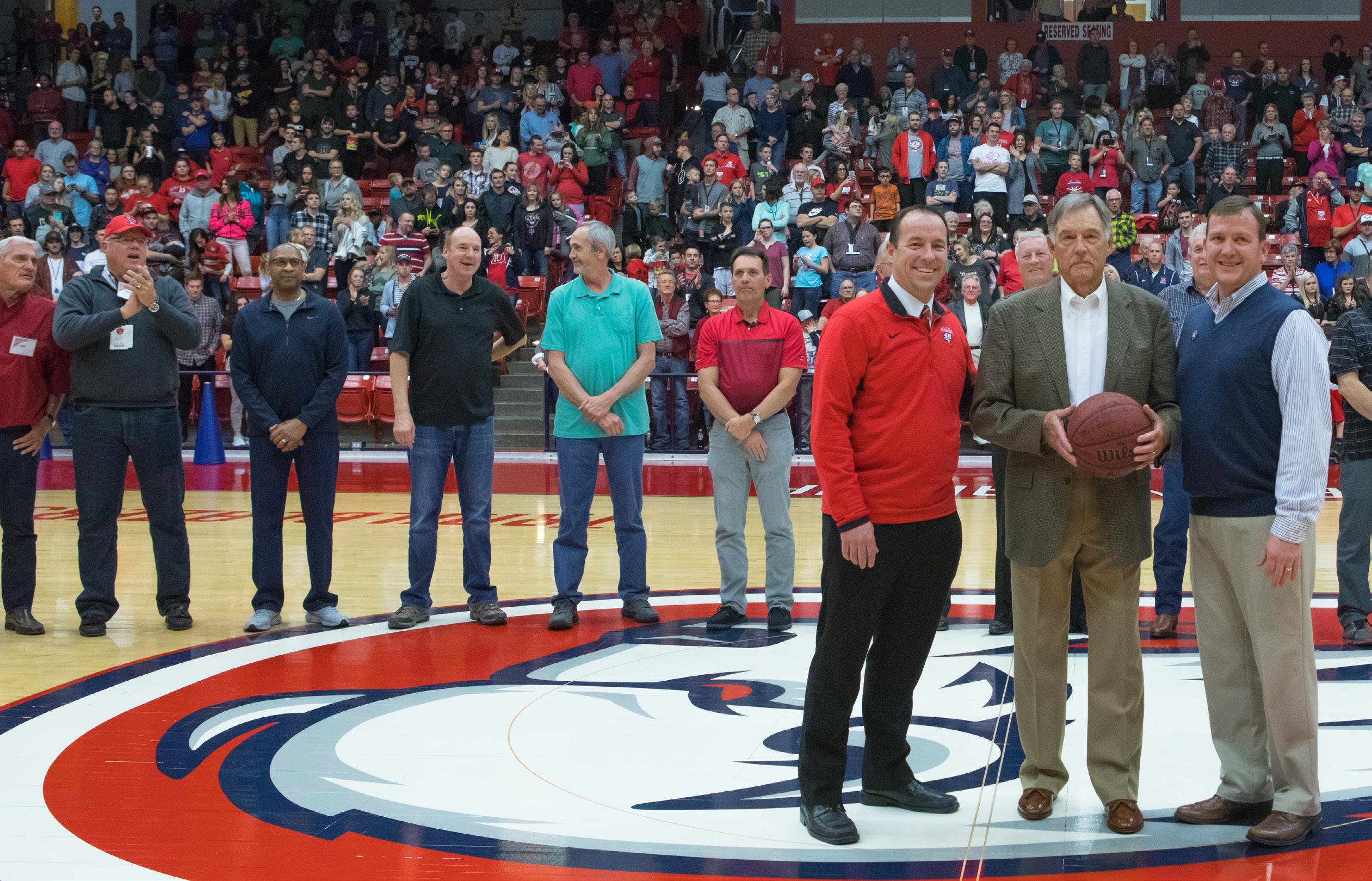
In his 15 years as head coach, Allred led his teams to two NJCAA National Championships and four Intermountain Collegiate Athletic Conference titles. In his last year as coach, he became the athletic director, a position he went on to hold for a total of 18 years.
Among Allred’s players in attendance were LDS Apostle Jeffrey R. Holland; Lionel Hollins, a former NBA player on the Portland Trail Blazers championship team and former head coach for the Memphis Grizzlies and Brooklyn Nets; and Nolan D. Archibald, former chairman of the board, president and CEO of the Black & Decker Corporation.
Most of his players admit to remembering Allred as a madman, allegedly dripping a bloody finger in a piranha aquarium to illustrate his definition of defense and wearing out his shoe sole from excessive stomping on the gym floor. Some even remember “riding the rack” for 15 miles on road trips when caught guilty of stinking up the car. But above all, they expressed their love for their coach and friend who taught them life lessons, both on and off the court.
The following night, the players stood on the Burns Arena floor in a special half-time presentation. The 83-year-old former coach stepped onto the court, met by applause from his players and a crowd on its feet. President Richard B. Williams and Athletic Director Jason Boothe then presented Allred with a basketball signed by the players whose lives he touched.
24 • Dixie State University Magazine • Spring 2017 HONORING COACH ALLRED
“I just love Coach Allred so very much. He’s had such a profound influence on my life and this is such a wonderful tribute to have this many people come back to show how much they love him.”
D. ARCHIBALD, ’68
Story by Joel Griffin & Photography by Scott Garrett, ’15
“Coach Allred always kept me on point. He laid a foundation for me because he was such a good person and made me do the right thing. I had a lot of talent, but he gave me a lot of discipline and structure.”


 - LIONEL HOLLINS,
- LIONEL HOLLINS,
“We wanted to win for him then and have been wanting to win for him ever since. We’ll always be Doug Allred’s kids. We love you, Coach.”
 - ELDER JEFFREY R. HOLLAND, ’63
- ELDER JEFFREY R. HOLLAND, ’63
25 #IWentToDixie • www.dixie.edu •
’73
on our fading stars

26 • Dixie State University Magazine • Spring 2017
Story by Joel Griffin
Photography by Alex Chamberlain, ’02
“Eight out of 10 kids born in the United States today will never see the Milky Way” — it’s the sad reality that DSU’s Alex Chamberlain, an assistant professor of art, explains has resulted from the lesser-known but ever-increasing problem of light pollution. “They’ll never experience a night sky dark enough,” he adds.

FOCAL POINT
To increase light pollution awareness, Chamberlain captures the beauty of the dark night skies in his photos and shows the contrast and stifling effect that cities’ man-made light domes have on starlight.

Artificial light has only existed for little more than a century, yet it has already pervaded our night sky. In fact, the only remaining site in the contiguous U.S. with a nearly pristine night sky, as classified by the Bortle Scale, is located in southern Utah’s Natural Bridges National Monument.

Compounding the problem is the mass move to cooler temperature LEDs, most of which emit bluer wavelengths that interfere with starlight more than warmer LEDs or traditional lights. This harsh lighting is disruptive to ecosystems, as in the case of migrating birds who can become disoriented by light domes and other artifacts of overlighting.
Along with wildlife, humans are also negatively impacted by harsh and prolonged exposure to light, which has been shown to interrupt our circadian rhythms and affects sleep patterns. “We, like every other species, have evolved to need darkness,” Chamberlain explains.
Fortunately, Chamberlain says the problem is quite easy to fix. “It’s lowhanging fruit as far as environmental causes go,” he says. “All it requires is a little bit of awareness and most people are on board.”
28 • Dixie State University Magazine • Spring 2017 FOCAL POINT
Light domes from Mesquite & St. George visible on the horizon

Shielding outdoor lights to point down and simply purchasing warmer LEDs or soft white rather than daylight bulbs is a great way to minimize light pollution on an individual or municipal level.

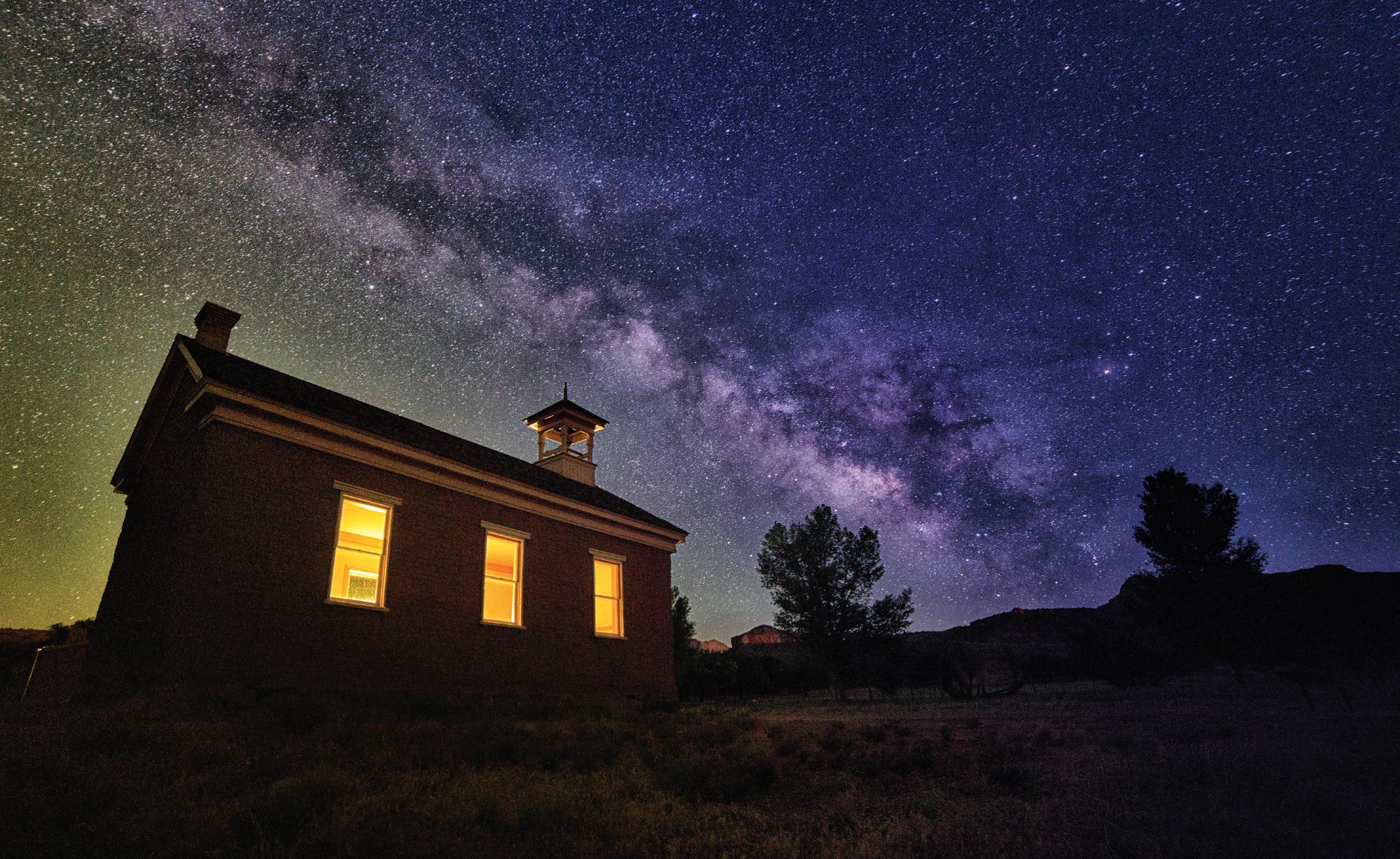
“We tend to take the stars for granted,” Chamberlain says. “But they will go away if we don’t realize that steps need to be taken.”

30• Dixie State University Magazine • Spring 2017 FOCAL POINT
CONVENIENTLY CLOSE TO CLASSES

NO EXTRA FEES (UTILITIES, CABLE, AND INTERNET INCLUDED)

LIVE-IN RESIDENT LIFE STAFF
CONNECTION TO CAMPUS RESOURCES




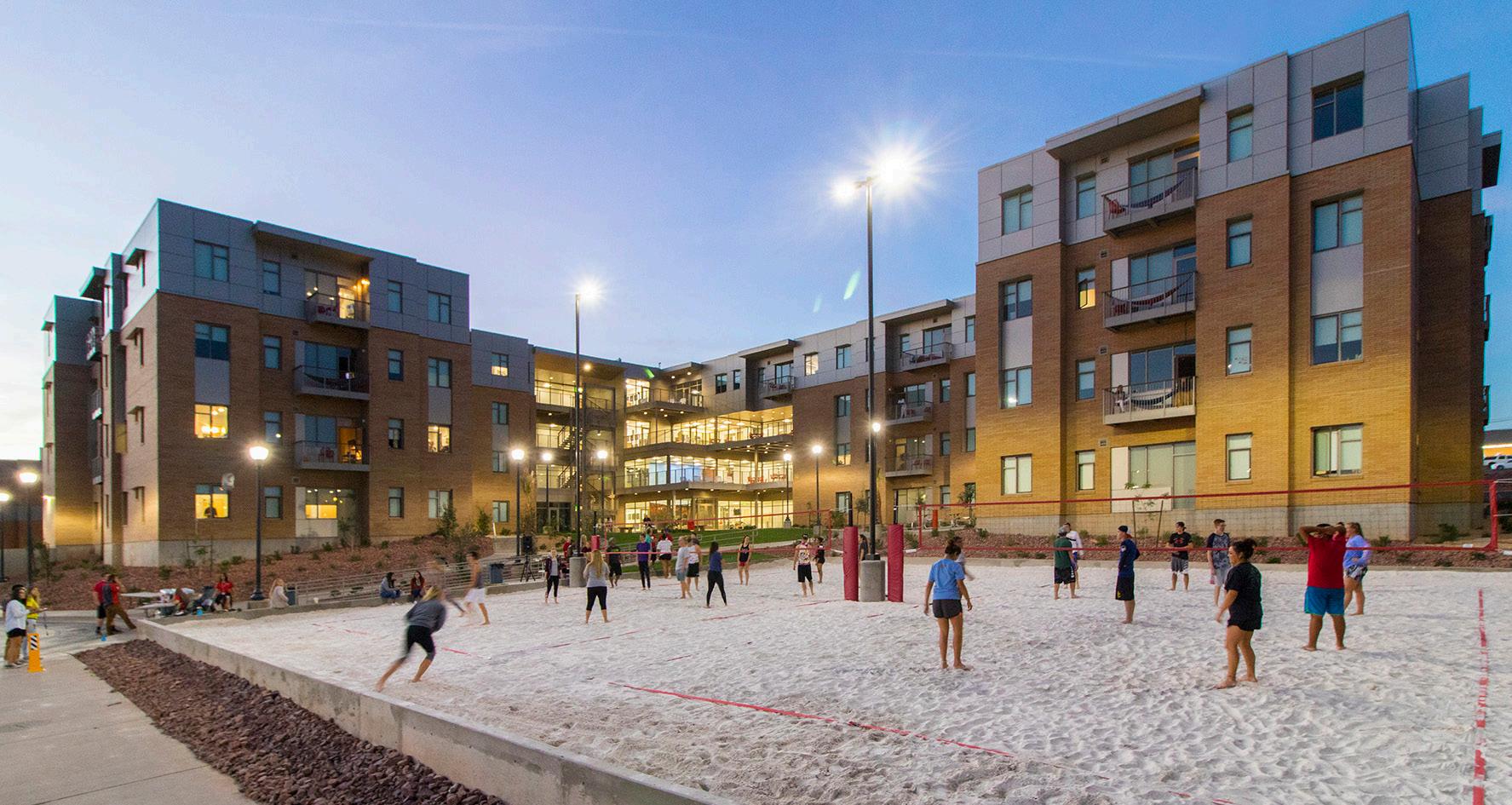


SUPER FUN STUDENT ACTIVITIES



SHARED & PRIVATE ROOMS AVAILABLE


#activelearningactivelife • www.dixie.edu • 31
APPLY NOW at HOUSING.DIXIE.EDU CALL 435-652-7570 FOR MORE INFO
IN
CAMPUS VIEW SUITES
THE BRAND NEW
REMEMBERING DIXIE Sark Arslanian
On December 11, 2016, Dixie State University Hall of Fame
Coach Sark Arslanian passed away at his home in St. George at the age of 92. Although gone, his influence at DSU will never be forgotten.
“The entire Dixie State Athletics family is very saddened by the loss of our friend and colleague Sark,” Director of Intercollegiate Athletics Jason Boothe said. “Without Sark’s leadership and passion for Dixie, our athletic teams would not be where they are today. He was not only a great coach and leader, but a caring man as well. He will be missed.”
Coach Sark, as he was known, was born on February 4, 1924, in Fresno, California. He graduated from Granite High School in 1941 and enlisted with the Naval Air Corps, for which he served as an officer in the South Pacific until the end of World War II.

He graduated from Dixie College in 1949, where he played football and basketball, ran track, and served as class president. He went on to earn a bachelor’s degree from the University of Utah and a master’s degree from Utah State University.
Arslanian began coaching at Central Junior High in Salt Lake City and continued his career at Union High School in Roosevelt. In 1955, he returned to St. George and became athletic director and head coach in football, track, and baseball at Dixie College.


32 • Dixie State University Magazine • Spring 2017 REMEMBERING
SARK
DIXIE STATE LEGEND Arslanian
His recruiting efforts nearly doubled the size of the college’s student body and served as a stabilizing factor for the institution.
He left behind a nationally ranked team at Dixie College to take over as head football coach at Weber State College in 1965, where his teams were also nationally ranked. From 1973 to 1982, he served as head football coach at Colorado State University. Following his time in Fort Collins, Arslanian became a professional scout for the Canadian and United States football leagues. Today, he is still noted as one of the most successful coaches in NCAA history.
Throughout his storied career, Arslanian touched the lives of hundreds of young men as a leader, mentor, and in some cases a father figure. Many of his players went on to lead successful careers and lives and credit Coach Sark for the example and leadership he provided. Several of those former players stayed in constant contact with Arslanian far after their playing careers had come to an end.

“He cared enough about other people that he wasn’t stingy with his love and consideration,” said DSU Assistant Professor Phil Tuckett, who played for Arslanian at Dixie College and Weber State. “He just radiated it. To me, that’s why, today, hundreds of his former players have similar fond feelings of
him as I do. His life was so big, it could not be contained or encapsulated by just his football success. I was honored to call him Coach and a friend.”
Arslanian coached professional teams in Milan, Italy, and Tokyo, Japan, and introduced American football in his family’s homeland of Armenia. After his retirement, he coached high school football teams in Colorado and Idaho, as well as St. George at Pine View High School.

Arslanian was inducted into the Dixie College Hall of Fame in 1999 and was part of the inaugural Dixie State Athletics Hall of Fame Class of 2007. On Sept. 14, 2013, the football field inside Legend Solar Stadium (then known as Hansen Stadium) was named Sark Arslanian Field in his honor for his contributions and achievements during his tenure at Dixie. The honor also coincided with the 50th anniversary of the 1963 Dixie College Football team going undefeated and untied — a first in the program’s history.
In addition, he is enshrined in the Pop Warner National Hall of Fame, Weber State Athletic Hall of Fame, Utah Sports Hall of Fame, and the All-American Football Foundation honor roll.
33 #DixieBlazers • www.dixie.edu •
Story by Steve Johnson
Meet the Class of 2017
Dixie State’s Athletic Hall of Fame features 33 individual inductees, including coaches, student-athletes, administrators, staff, and volunteers. In addition, three championship-winning teams have also been enshrined. This year, the following five individuals were inducted into the ninth Athletic Hall of Fame class, on Jan. 28, during a special ceremony in the Cox Performing Arts Center and were recognized during halftime of the DSU vs. Hawai’i Hilo men’s basketball game.
Mike Littlewood (1997-2012)

Mike Littlewood managed the Dixie State dugout for 16 years and is the program’s all-time winningest coach, having compiled a 605-249 (.708) overall record. Littlewood led Dixie State to 40 or more victories each year for eight seasons and met or topped the 50-win plateau in 2001 (50-12) and again in 2004 (51-14). In fact, Dixie State never had a losing season during the Littlewood era. During his tenure, Dixie State won nine league titles, including seven Scenic West Athletic Conference championships in junior college play and two Pacific West Conference crowns in 2009 and 2011 after the program’s move to NCAA Division II membership. Littlewood also led Dixie to four NJCAA World Series appearances and the 2004 NJCAA national championship, along with a 2001 national runner-up finish. In addition, Littlewood had 29 players drafted by Major League Baseball teams during his time at Dixie.
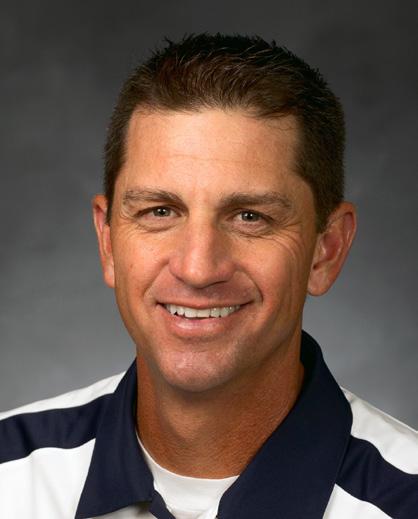
Rachel Perkins Young (2011-12)
In only two seasons, Rachel Perkins Young established herself as one of the best overall student-athletes in Dixie State history. During her junior season in 2011, she became the first DSU runner to win the PacWest individual cross country title and posted a 10th-place finish at the NCAA West Regional race en route to being awarded DSU Female Athlete of the Year honors. Perkins Young enjoyed even more success as a senior when she won two more races, earned First Team all-PacWest and all-NCAA West Region accolades. Additionally, she became the first Dixie cross country athlete to earn All-America honors and placed 28th overall at the NCAA National Championship race in Joplin, Missouri. Her performances earned Perkins Young her second DSU Female Athlete of the Year award. Perkins Young currently holds the school’s six-kilometer record (21:10) and owns four of the top-10 fastest 5K times, and three of the top-10 fastest 6K marks in school history.

ATHLETIC HALL OF FAME
Story by Steve Johnson Design by Josh Bodell
Mike Littlewood photo courtesy of BYU Athletic Media Relations
Brandon Kintzler (2004)


Brandon Kintzler played a vital role on Dixie State’s 2004 NJCAA national championship team. The right-hander appeared in 13 games with 12 starts and finished with a 9-1 record with a 2.30 earned run average and 69 strikeouts in 74.1 innings pitched. Kintzler hurled one complete-game shutout, was part of three more shutout wins, and posted four complete-game efforts overall as he helped anchor one of the nation’s top pitching staffs. That summer, Kintzler was drafted in the 40th round of the Major League Baseball June Amateur Draft by the San Diego Padres. Following six-plus years in the minors, Kintzler made his major league debut with the Milwaukee Brewers on Sept. 10, 2010, and is currently a relief pitcher for the Minnesota Twins.
 Brandon Kintzler head shot & action photos courtesy of the Minnesota Twins/Brace Hemmelgarn
Brandon Kintzler head shot & action photos courtesy of the Minnesota Twins/Brace Hemmelgarn
Corry Jones (1961-63)
Corry Jones will go down in the annals of Dixie’s storied history as one of the greatest athletes ever to compete at the institution. Jones was a four-sport letter winner in football, basketball, baseball, and track & field in his two years in St. George. He helped lead the Rebels to a 9-1 record on the gridiron in 1962 under legendary Dixie Hall of Fame Coach Sark Arslanian. Jones then turned around and served as team co-captain on Dixie’s 1963 Intermountain Collegiate Athletic Conference (ICAC) men’s basketball championship-winning team for Dixie Hall of Fame Coach Doug Allred. He even earned all-ICAC honors in both sports. Then, for good measure, he was the Rebels’ starting left fielder and top hitter on the Dixie College baseball team and threw the javelin and competed in the high jump on the track & field team. For all his efforts, Jones was named the 1963 Dixie College Athlete of the Year.



Stan Plewe (1978-current)
Stan Plewe has been a part of the Dixie State fabric for nearly 40 years. He worked for six presidents overall, including his service as a vice president to three presidents. Through his vision and leadership, a number of the University’s current programs, services, and facilities were created or constructed during his tenure at the institution. Plewe retired from his role as an administrator in 2012, but his involvement at Dixie State is alive and well. One of his many hobbies is photography, and prior to and since his retirement, Plewe, with camera in hand, has roamed the sidelines documenting all the excitement of Dixie State Athletics. He has served in his volunteer “side job” for several years, donating his time and talents to capture every snap, pass, shot, rebound, serve, hit, catch, pitch, drive, putt, win, and loss — both at home and on the road.

ATHLETIC HALL OF FAME


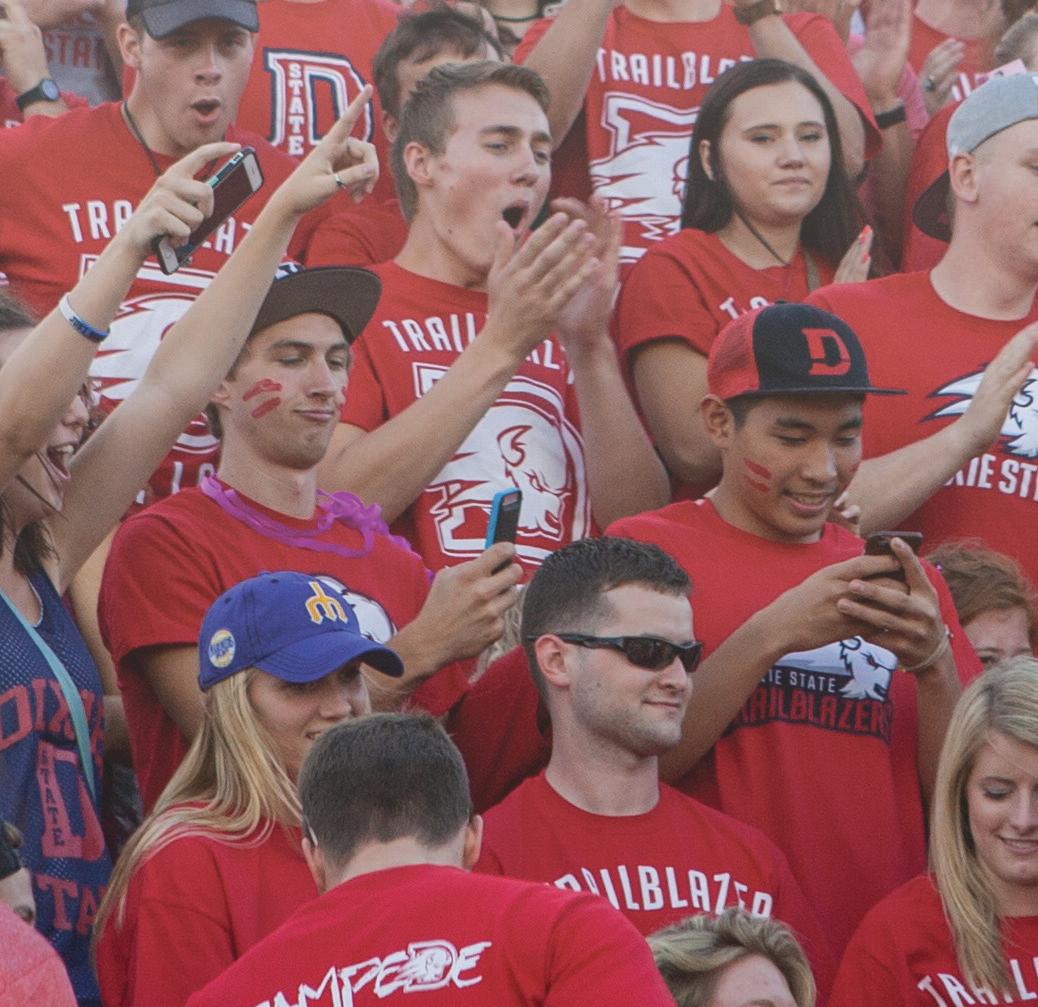


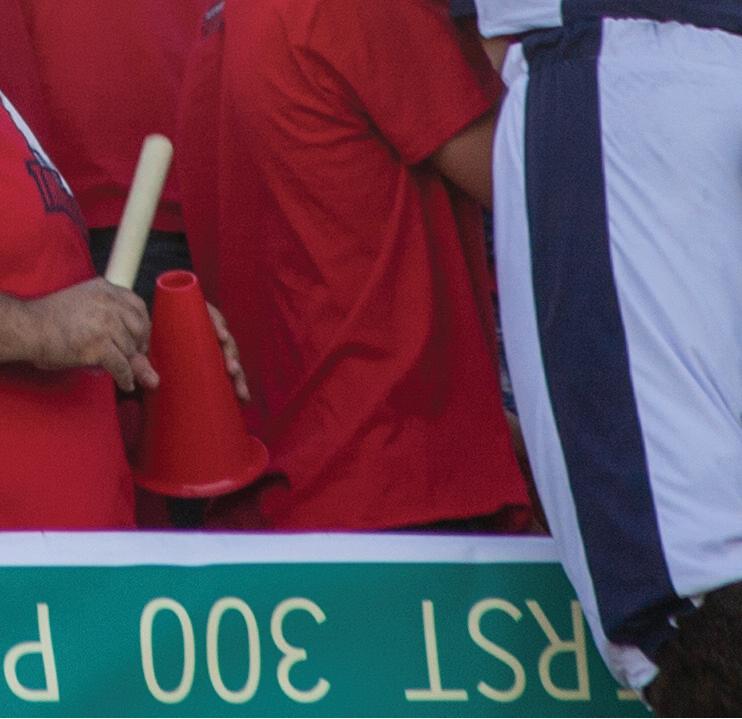



#activelearningactivelife • www.dixie.edu • 37 225 South University Avenue | St. George, UT (2nd floor of the Gardner Center) or shop online at campusstore.dixie.edu ARE YOU GAME DAY READY?











@DixieState @DStateAlumni U.S. Postage PAID Non-Profit Org. PERMIT NO. 36 Provo, UT @DixieStateUniversity @DixieStateAlumni Dixie State University Dixie State University Alumni @dixiestate @dixiestatealumni Dixie State University Alumni Association 225 South University Avenue St. George, UT 84770 435-652-7500 www.dixie.edu explore.dixie.edu


 Inside Cover Photo: Bryce Parker
Inside Cover Photo: Bryce Parker






































































 - LIONEL HOLLINS,
- LIONEL HOLLINS,
 - ELDER JEFFREY R. HOLLAND, ’63
- ELDER JEFFREY R. HOLLAND, ’63































 Brandon Kintzler head shot & action photos courtesy of the Minnesota Twins/Brace Hemmelgarn
Brandon Kintzler head shot & action photos courtesy of the Minnesota Twins/Brace Hemmelgarn























